A bit of testing of the estimation of the variance matrix for S&P 500 stocks in 2011.
Previously
There was a plot in “Realized efficient frontiers” showing the realized volatility in 2011 versus a prediction of volatility at the beginning of the year for a set of random portfolios. A reader commented to me privately that they expected the plot not to be so elliptical — that they expected there to be higher dispersion for high volatility portfolios.
My initial hypothesis was that maybe the Ledoit-Wolf estimate is better than the factor models that the reader is used to. We’ll test that and a few other hypotheses.
The realized period in this post is all of 2011.
Figure 1 shows the realized and predicted volatility of 10,000 random portfolios.
Figure 1: Ledoit-Wolf estimate with linearly decreasing weights on a 1 year lookback for portfolios with risk fraction constraints. 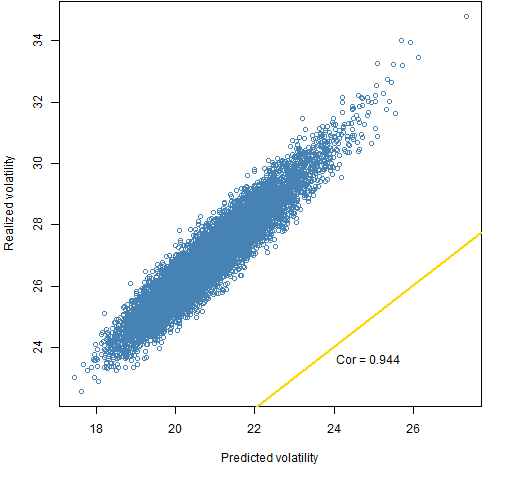 This shows the correlation among the random portfolios and the line where predicted and realized are equal. Many tests of variance matrices use one portfolio and look at the vertical distance between that portfolio and the equality line. That’s not really much of a test.
This shows the correlation among the random portfolios and the line where predicted and realized are equal. Many tests of variance matrices use one portfolio and look at the vertical distance between that portfolio and the equality line. That’s not really much of a test.
The future is very likely to be either more volatile or less volatile than the sample period. The plots here suggest that getting the level right is just a matter of a single scaling parameter.
What is more important — certainly in the context of optimization — is knowing which of two portfolios will have the larger volatility. That is, the correlation between realized and predicted is really of interest.
Estimators
My hypothesis was that perhaps factor models wouldn’t be as good as Ledoit-Wolf shrinkage. Figure 2 is the same as Figure 1 except that a statistical factor model is used instead of Ledoit-Wolf to predict volatility.
Figure 2: Statistical factor estimate with linearly decreasing weights on a 1 year lookback for portfolios with risk fraction constraints. 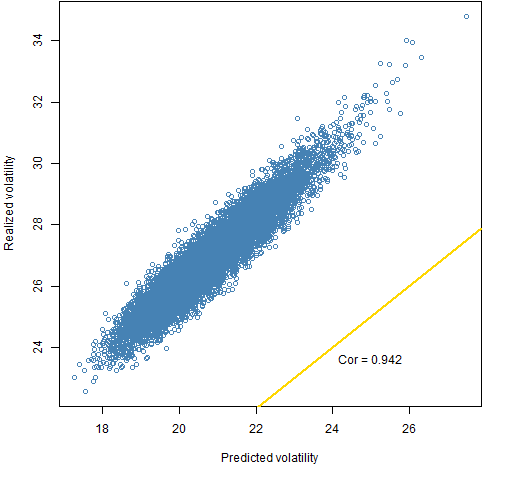
Figures 1 and 2 are close to identical with Ledoit-Wolf nosing out the statistical factor model. It would be interesting to see results for other factor models.
Constraints
The random portfolios in Figures 1 and 2 were generated with the constraints:
- long-only
- 90 to 100 names
- no asset can contribute more than 3% to the portfolio variance
Figure 3 shows what happens when we replace the last constraint with:
- no asset can contribute more than 3% weight
Figure 3: Ledoit-Wolf estimate with linearly decreasing weights on a 1 year lookback for portfolios with weight constraints. 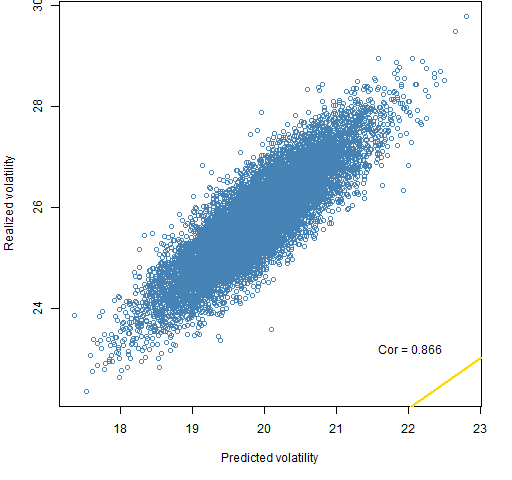 Figure 3 has a much lower correlation than Figure 1. However, that is not a general result. The presentation “Portfolio optimisation inside out” shows a case where the weight constraints have a higher correlation than the corresponding risk fraction constraints.
Figure 3 has a much lower correlation than Figure 1. However, that is not a general result. The presentation “Portfolio optimisation inside out” shows a case where the weight constraints have a higher correlation than the corresponding risk fraction constraints.
An important difference in the present case is that the range of predicted volatilities is much narrower for the weight constraints, so it is natural for the correlation to be lower.
Time weights
It is possible to give more weight to some observations than others. The default weighting in the variance estimators (Ledoit-Wolf and statistical factor) in the BurStFin package is linearly decreasing. The most recent observation has 3 times the weight of the first observation in the sample period. That is the weighting used in Figures 1 through 3.
Figure 4 uses equal weights for all the sample period, which is 2010.
Figure 4: Ledoit-Wolf estimate with equal weights on a 1 year lookback for portfolios with risk fraction constraints. 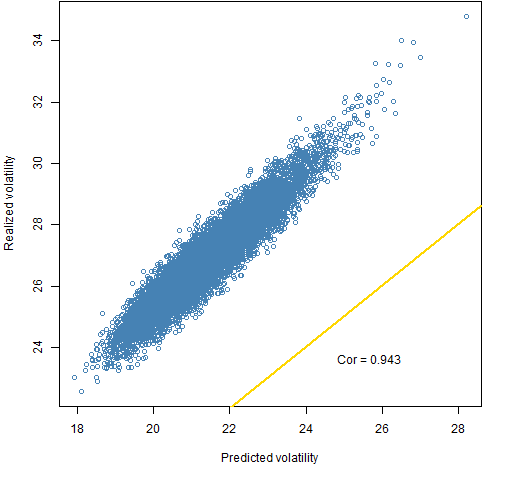
This is barely worse than using the linearly decreasing weights.
Lookback
The size of the sample period is an extreme form of controlling time weights. The time weights of observations too far back in time are set to zero.
Figure 5: Ledoit-Wolf estimate with linearly decreasing weights on a 5 year lookback for portfolios with risk fraction constraints. 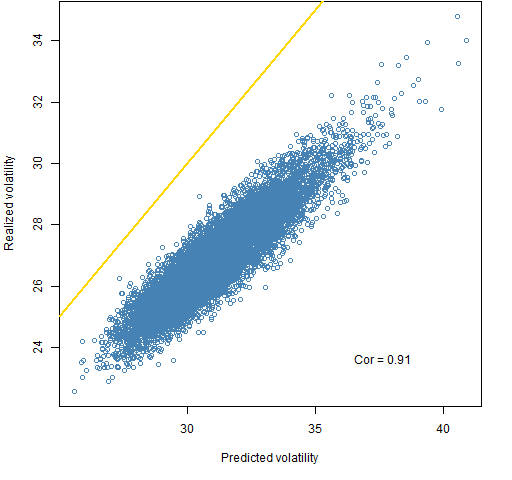
The five-year sample period is worse than the one-year period.
Caveat
You shouldn’t think that we’ve really learned anything here. In order to get a firm sense of what works best we need to do this sort of thing over multiple times. The market changes. Different periods are different. What we’ve seen here is just for one period.
However, for this one period the observations are:
- risk fraction constraints give higher correlation than weight constraints (this is known to be time-dependent, and in this case not a valid comparison of accuracy)
- 1-year lookback is better than 5-year lookback
- linearly decreasing weights are slightly better than equal weights
- Ledoit-Wolf shrinkage is slightly better than the statistical factor model
Summary
Using random portfolios to test variance matrix estimators provides vastly more useful information than the alternative.
The details of variance estimation seem to be fairly unimportant. I of course mean within reasonable limits — the sample variance isn’t going to do when there are more assets than observations.
Questions
If we wanted to get a subset of the risk fraction random portfolios that had approximately the same distribution of predicted volatility as the weight constraint random portfolios, what would be a good way of selecting the subset?
Epilogue
It turned out to be the howling of a dog
Or a wolf, to be exact.
The sound sent shivers down my back
from “Furr” by Eric Earley
Appendix R
An explanation of the R computations is given in “Realized efficient frontiers” but a few extra things were done here.
The statistical factor model as well as the Ledoit-Wolf estimator is from the BurStFin package.
require(BurStFin)
var.sf.10.lw <- factor.model.stat(sp5.ret[1007:1258, ])
The command to get equal weights is:
var.lw.10.qw <- var.shrink.eqcor(sp5.ret[1007:1258, ], weight=rep(1,252))
safety tip
This analysis involved two sets of random portfolios. It would be easy to mix objects concerning the two sets. But there is a trick to reduce that possibility.
The first set of random portfolios contained 10,000 portfolios. The second was created to have 10,001 portfolios. Mixing up objects in this case is very likely to produce either an error or a warning.

The plots look terrific when plotted with anti-aliased device such as
library(cairoDevice)
Cairo()
Cairo_png()
Just a humble suggestion. Really enjoying your work.
Stanislav,
Thanks. Some day when I’m not being lazy I’ll try it out.
Hi
I just wanted to ask why:
” look at the vertical distance between that portfolio and the equality line.” is not really much of a test? isnt the distribution of a distance defined properly?
Thanks
Eran,
Sorry for the late reply — somehow I didn’t see the notice of your comment.
The problem isn’t with the distance — the point clouds imply that the distance is quite well defined.
One problem is that it is a one-dimensional test of a multi-dimensional model. In particular, that one dimension is pretty much completely irrelevant for portfolio optimization. What matters there is knowing which portfolios will have lower volatility, not really the value of the volatility.
The phenomenon of variance clustering is ubiquitous in markets — volatility goes up and down over time. And the moves are to some extent unpredictable. The general level of volatility is going to either be lower or higher than the risk model says. We don’t know which, but we can be pretty sure the model will have the level wrong.
You can test how close it is over multiple time periods. It will take a long time to get significant results doing this. The methodology of creating the model may change over time, so you’ll have data snooping problems. You also have to decide on a time horizon — you can make the model look better or worse by changing the horizon you assume.
Hi Pat,
Despite the fact that you can conclude on the distance, since you test only one portfolio, its not really meaningful for future portfolio construction, think that is what I missed.
Thanks for the post and the reply.
Pingback: Popular posts 2012 May | Portfolio Probe | Generate random portfolios. Fund management software by Burns Statistics
Pingback: 2 dimensions of portfolio diversity | Portfolio Probe | Generate random portfolios. Fund management software by Burns Statistics